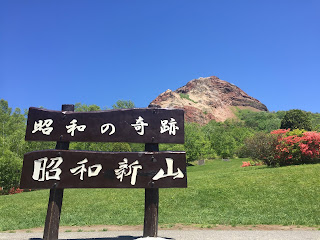火山資料展示室(位於洞爺湖町)比鄰於在2000年有珠山噴發時,因國道230號道路下陷而形成的西新山沼。當時,這個建築物是洞爺湖區域的消防局本部。為了要展示火山的資料而再度使用這個建築物。特地保存了當時地板稍微傾斜的狀態。有照片等相關資料。
The Exhibition Room of Volcanic Materials of Mt. Usu (Toyako Town) is next to Nishi Shinzan Numa, which is a big pond created by the volcanic activity of Mt. Usu in 2000. After part of route 230 caved-in, the pond was created. The building housing this exhibition room used to be the headquarters of fire defense for the area around Lake Toya. After it was damaged, the headquarters moved to the different location. The building then became the present exhibition facility, although the floor is slightly off flat. There are many photos to inform people of what the volcanic activities in 2000 were like.

























































